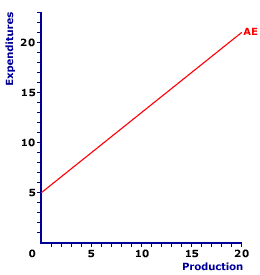
|
|
CAPITAL ACCOUNT: One of two parts of a nation's balance of payments. The capital is a record of all purchases of physical and financial assets between a nation and the rest of the world in a given period, usually one year. On one side of the balance of payments ledger account are all of the foreign assets purchase by our domestic economy. On the other side of the ledger are all of our domestic assets purchased by foreign countries. The capital account is said to have a surplus if a nation's investments abroad are greater than foreign investments at home. In other words, if the good old U. S. of A. is buying up more assets in Mexico, Brazil, and Hungry, than Japanese, Germany, and Canada investors are buying up of good old U. S. assets, then we have a surplus. A deficit is the reverse.
Visit the GLOSS*arama
|
|


|

|
                           INTERCEPT, AGGREGATE EXPENDITURES LINE: The intercept of the aggregate expenditures line indicates autonomous expenditures, aggregate expenditures that do not depend on the level of income or production. This can be thought of as aggregate expenditures that the four macroeconomic sectors (household, business, government, and foreign) undertake regardless of the state of the economy. Autonomous expenditures are affected by the aggregate expenditures determinants, which cause a change in the intercept and a shift of the aggregate expenditures line. | Aggregate Expenditures Line | 
|
The aggregate expenditures line, which embodies the key Keynesian principle of effective demand, shows the relation between aggregate expenditures and the actual level of aggregate income or production in the domestic economy. The income and production measures commonly used are national income and gross domestic product.The two basic types of expenditures--autonomous and induced--are indicated by the aggregate expenditures line. - Autonomous expenditures are the vertical intercept, or Y-intercept, of the aggregate expenditures line. This is the sum of autonomous consumption, autonomous investment, autonomous government purchases, and autonomous net exports, with an adjustment for autonomous taxes.
- Induced expenditures are the slope of the aggregate expenditures line. The marginal propensity to consume (MPC), which is the slope of the consumption line, forms the foundation of the slope of the aggregate expenditures line. This slope, however, is augmented by the marginal propensity to invest (MPI), marginal propensity for government purchases (MPG), and marginal propensity to import (MPM).
A representative aggregate expenditures line is presented in the exhibit to the right. This red line, labeled AE in the exhibit, is positively sloped, indicating that greater levels of income generate greater aggregate expenditures by the four sector. This positive relation is primarily based on the Keynesian psychological law indicating that consumption expenditures are induced by household income. However, this positive slope is reinforced and augmented by induce investment, government purchases, and net exports.The intercept of the aggregate expenditures line indicates the intersection point between the aggregate expenditures line and the vertical expenditures axis. The aggregate expenditures line intersects the vertical axis in this exhibit at a value of $5 trillion. Theoretically, this is a minimum "baseline" level of aggregate expenditures, the amount of investment undertaken if income and production fall to zero. This intersection indicates autonomous expenditures--aggregate expenditures unrelated to income. Click the [Intercept] button to illustrate. Autonomous expenditures are aggregate expenditures by the household, business, government, and foreign sectors that are unrelated to and unaffected by the level of income or production. This is best indicated by a zero level of income. While individuals, business firms, government agencies, or foreign entities might occasionally come face-to-face with autonomous expenditures, as their own slice of aggregate income drops to zero, for the aggregate economy autonomous expenditures is mostly an unlikely theoretical extrapolation. However, from an analytical perspective, the intercept of the aggregate expenditures line is affected by the aggregate expenditures determinants. These are ceteris paribus factors other than income and production that affect aggregate expenditures, but which are held constant when the aggregate expenditures line is constructed. A few of the more important determinants are interest rates, expectations, fiscal policy, and wealth. Any change in these determinants cause the aggregate expenditures line to shift, which necessarily means a new intercept and a new level of autonomous expenditures.

Recommended Citation:INTERCEPT, AGGREGATE EXPENDITURES LINE, AmosWEB Encyclonomic WEB*pedia, http://www.AmosWEB.com, AmosWEB LLC, 2000-2024. [Accessed: May 19, 2024].
Check Out These Related Terms... | | | | | | | | | |
Or For A Little Background... | | | | | | | | | | | | | | | |
And For Further Study... | | | | | | | | | | |
Search Again?
Back to the WEB*pedia
|



|

|
GREEN LOGIGUIN
[What's This?]
Today, you are likely to spend a great deal of time browsing through a long list of dot com websites seeking to buy either a looseleaf notebook binder or hand lotion, a big bottle of hand lotion. Be on the lookout for rusty deck screws.
Your Complete Scope
This isn't me! What am I?
|

|
|
Potato chips were invented in 1853 by a irritated chef repeatedly seeking to appease the hard to please Cornelius Vanderbilt who demanded french fried potatoes that were thinner and crisper than normal.
|

|
|
"The only place success comes before work is in the dictionary. " -- Vince Lombardi
|

|
SPE
Subgame Perfect Equilibrium
|

|
|
Tell us what you think about AmosWEB. Like what you see? Have suggestions for improvements? Let us know. Click the User Feedback link.
User Feedback
|


|


